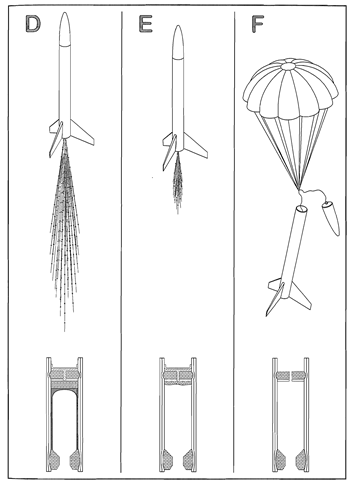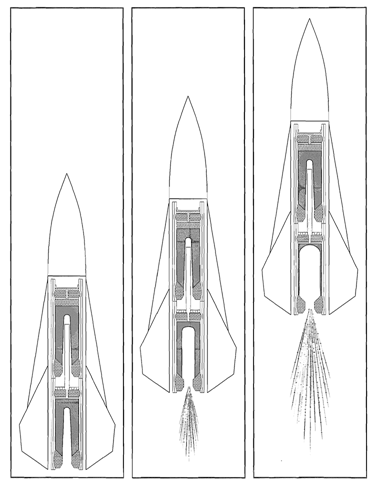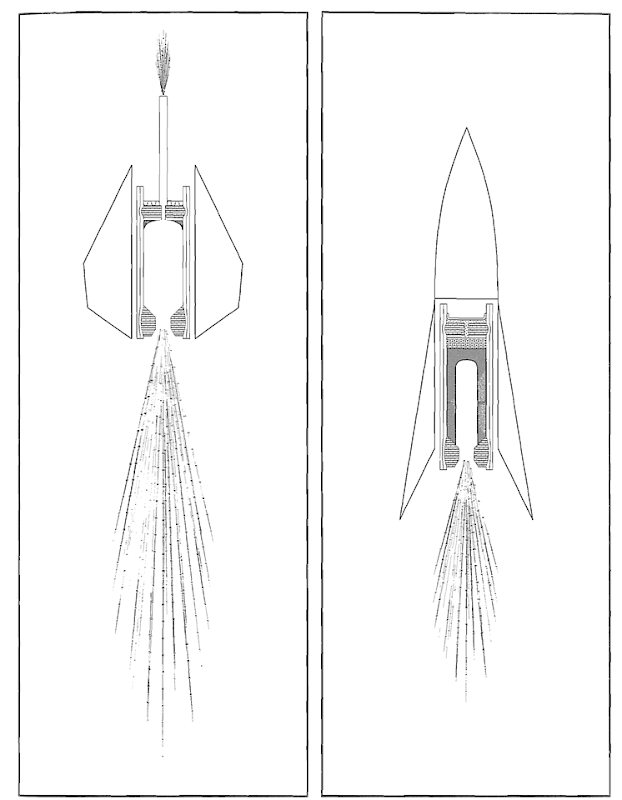A single stage rocket uses a single rocket motor or a cluster of motors to lift its payload to the desired altitude, and most low altitude sounding rockets are of the single stage type. Figure 2-12 shows what happens during the flight of a single stage rocket. Below each rocket drawing is a drawing of its motor, and you’ll notice that I’ve labeled the drawings with the letters. A through F.
If you look at Figure 2-11. you’ll see the thrust-time curve of a long, cylindrical core burner. I’ve included a time delay at the end of the motor’s burn, and the small pulse generated by the parachute ejection charge. In this example the delay is 3 seconds long. I’ve marked 6 points along the curve with the letters. A through F. Each of these points corresponds to one of the drawings in Figure 2-12, and each drawing shows what the rocket and its motor are doing at that point on the curve.

Figure 2-12. The flight of a single stage rocket.

Figure 2-12. The flight of a single stage rocket.

Figure 2-13. A two stage rocket just Figure 2-14. The propellant is begin- Figure 2-15. Most of the booster’s before lift off.ning to burn. The motor’s thrust has propellant has been consumed, and exceeded the rocket’s weight, and the the rocket is in full flight brocket has lifted off the ground.

Figure 2-16. The booster’s flame tube has ignited the Figure 2-17. The second stage has separated from the booster.
second stage motor, and the booster has dropped away. and it’s beginning to generate thrust. It will eventually reach
a higher altitude than either itself or the booster would have reached, had either been launched alone.
At point A the rocket is sitting on the launch pad. fully loaded and ready to fly. At point B the motor has ignited, and the propellant is beginning to burn. The motor has developed enough thrust to overcome the rocket’s weight, and the rocket has lifted off the ground. At point C the motor’s chamber pressure is rapidly increasing, and so is the amount of propellant burning at each moment. The motor’s thrust is also increasing, and the rocket is accelerating upward at an ever-increasing rate.
At point D the motor’s thrust and the rocket’s acceleration have reached their maximums, and the last of the propellant is being consumed. At point E the flame has moved into the time delay, and it’s burning slowly toward the hole in the forward bulkhead. At point F the flame has reached the hole, flashed through the hole, and ignited the ejection charge. The ejection charge has popped off the nose cone and pushed out the parachute. Motors with different grain geometries produce different thrust-time curves, but the basic sequence of events is always the same.
Single Stage Rockets (Rocket Motor)
Next post: Motor Classification (Rocket Motor)
Previous post: Two Stage Rockets (Rocket Motor)
